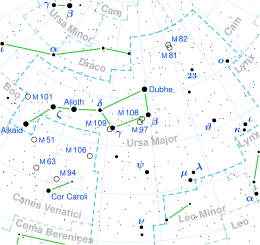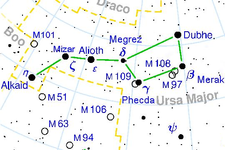Alcor (star)
Location of Alcor (Mizar is circled, Alcor is invisible beside it at this scale) | |
| Observation data Epoch J2000.0 Equinox J2000.0 | |
|---|---|
| Constellation | Ursa Major |
| Right ascension | 13h 25m 13.53783s[1] |
| Declination | +54° 59′ 16.6548″[1] |
| Apparent magnitude (V) | +3.99[2] |
| Characteristics | |
| Spectral type | A5Vn[3] / M3-4[4] |
| Astrometry | |
| Radial velocity (Rv) | −9.6[5] km/s |
| Parallax (π) | 39.91 ± 0.13 mas[1] |
| Distance | 81.7 ± 0.3 ly (25.06 ± 0.08 pc) |
| Absolute magnitude (MV) | +2.00[2] |
| Details | |
| Alcor A | |
| Mass | 1.84[6] M☉ |
| Radius | 1.846[7] R☉ |
| Luminosity | 14.03[6] L☉ |
| Surface gravity (log g) | 4.25[8] cgs |
| Temperature | 8,221[8] K |
| Rotational velocity (v sin i) | 228[6] km/s |
| Alcor B | |
| Mass | 0.25[4] M☉ |
| Age | 0.5 ± 0.1[2] Gyr |
| Other designations | |
| Database references | |
| SIMBAD | data |
Alcor is the fainter companion of Mizar, the two stars forming a naked eye double in the handle of the Big Dipper (or Plough) asterism in the constellation of Ursa Major. The two both lie about 83 light-years away from the Sun, as measured by the Hipparcos astrometry satellite.
Nomenclature
Alcor has the Flamsteed designation 80 Ursae Majoris. Alcor was originally Arabic سها Suhā/Sohā, meaning either the ‘forgotten’ or ‘neglected’ one.; notable as a faintly perceptible companion of Mizar.[9]
In 2016, the International Astronomical Union organized a Working Group on Star Names (WGSN)[10] to catalog and standardize proper names for stars. The WGSN's first bulletin of July 2016[11] included a table of the first two batches of names approved by the WGSN; which included Alcor for 80 UMa.[12]
Stellar system
With normal eyesight Alcor appears at about 12 minutes of arc from Mizar. Alcor is of magnitude 3.99 and spectral class A5V. It has a faint red dwarf companion separated by 1 second of arc.[4]
Mizar and Alcor's proper motions show they move together, along with most of the other stars of the Big Dipper except Dubhe and Alkaid, as members of the Ursa Major Moving Group, a mostly dispersed group of stars sharing a common birth. However, it has yet to be demonstrated conclusively that they are gravitationally bound. Recent studies indicate that the Alcor binary and Mizar quadruple are somewhat closer together than previously thought: approximately 74,000 ± 39,000 AU or 0.5–1.5 light years. The uncertainty is due to our uncertainty about the exact distances from us. If they are exactly the same distance from us (somewhat unlikely) then the distance between them is only 17800 AU (0.281 ly).[2]
-
The Big Dipper's bowl and part of the handle photographed from the International Space Station. Mizar and Alcor are at the upper right.
-
Big Dipper map
Other names
Alcor was known as Arundhati, one of the Saptarishi, in traditional Indian astronomy.[13]
Al-Sahja was the rhythmical form of the usual Suhā/Sohā. It appears as الخوّار al-Khawwar, 'the Faint One', [14]
Mizar is Chickadee and Alcor is his cooking pot in the Mi'kmaq myth of the great bear and the seven hunters.[15]
Military namesakes
USS Alcor (AD-34) and USS Alcor (AK-259) are both United States Navy ships.
References
- ^ a b c van Leeuwen, F. (November 2007). "Validation of the new Hipparcos reduction". Astronomy and Astrophysics. 474 (2): 653–664. arXiv:0708.1752. Bibcode:2007A&A...474..653V. doi:10.1051/0004-6361:20078357.
- ^ a b c d Mamajek, Eric E.; Kenworthy, Matthew A.; Hinz, Philip M.; Meyer, Michael R. (2010). "Discovery of a Faint Companion to Alcor Using MMT/AO 5 μm Imaging". The Astronomical Journal. 139 (3): 919–925. arXiv:0911.5028. Bibcode:2010AJ....139..919M. doi:10.1088/0004-6256/139/3/919.
- ^ Gray, R. O; Garrison, R. F (1989). "The late A-type stars - Refined MK classification, confrontation with Stromgren photometry, and the effects of rotation". Astrophysical Journal Supplement Series. 70: 623. Bibcode:1989ApJS...70..623G. doi:10.1086/191349.
- ^ a b c Zimmerman, Neil; Oppenheimer, Ben R; Hinkley, Sasha; Brenner, Douglas; Parry, Ian R; Sivaramakrishnan, Anand; Hillenbrand, Lynne; Beichman, Charles; Crepp, Justin R; Vasisht, Gautam; Roberts, Lewis C; Burruss, Rick; King, David L; Soummer, Rémi; Dekany, Richard; Shao, Michael; Bouchez, Antonin; Roberts, Jennifer E; Hunt, Stephanie (2010). "Parallactic Motion for Companion Discovery: An M-Dwarf Orbiting Alcor". The Astrophysical Journal. 709 (2): 733–740. arXiv:0912.1597. Bibcode:2010ApJ...709..733Z. doi:10.1088/0004-637X/709/2/733.
- ^ Kidger, Mark R; Martín-Luis, Fabiola (2003). "High-Precision Near-Infrared Photometry of a Large Sample of Bright Stars Visible from the Northern Hemisphere". The Astronomical Journal. 125 (6): 3311. Bibcode:2003AJ....125.3311K. doi:10.1086/374996.
- ^ a b c Zorec, J; Royer, F (2012). "Rotational velocities of A-type stars. IV. Evolution of rotational velocities". Astronomy & Astrophysics. 537: A120. arXiv:1201.2052. Bibcode:2012A&A...537A.120Z. doi:10.1051/0004-6361/201117691.
- ^ Jones, Jeremy; White, R. J; Boyajian, T; Schaefer, G; Baines, E; Ireland, M; Patience, J; Ten Brummelaar, T; McAlister, H; Ridgway, S. T; Sturmann, J; Sturmann, L; Turner, N; Farrington, C; Goldfinger, P. J (2015). "The Ages of A-Stars. I. Interferometric Observations and Age Estimates for Stars in the Ursa Major Moving Group". The Astrophysical Journal. 813: 58. arXiv:1508.05643. Bibcode:2015ApJ...813...58J. doi:10.1088/0004-637X/813/1/58.
- ^ a b David, Trevor J; Hillenbrand, Lynne A (2015). "The Ages of Early-type Stars: Strömgren Photometric Methods Calibrated, Validated, Tested, and Applied to Hosts and Prospective Hosts of Directly Imaged Exoplanets". The Astrophysical Journal. 804 (2): 146. arXiv:1501.03154. Bibcode:2015ApJ...804..146D. doi:10.1088/0004-637X/804/2/146.
- ^ Bohigian, George M. (2008). "An Ancient Eye Test—Using the Stars". Survey of Ophthalmology. 53 (5): 536–9. doi:10.1016/j.survophthal.2008.06.009. PMID 18929764.
- ^ "IAU Working Group on Star Names (WGSN)". Retrieved 22 May 2016.
- ^ "Bulletin of the IAU Working Group on Star Names, No. 1" (PDF). Retrieved 28 July 2016.
- ^ "IAU Catalog of Star Names". Retrieved 28 July 2016.
- ^ V.Chandran (1993-01-01). Astronomy Quiz Book. Pustak Mahal, 1993. ISBN 978-81-223-0366-7.
... the seven rishis in the constellation Saptarishi (Ursa Major) ... In Vasishta (Zeta), its tiny companion star is named after Arundhati, the wife of Vasishta ... today known by their Arabic names Dubhe (Kratu), Merak (Pulaha), Phekda (Pulastya), Megrez (Atri), Benetnash (Marichi) and Mizar (Vasishta) ...
- ^ list of Arabic star names, published in Popular Astronomy, January 1895, by Professor Robert H. West, of the Syrian Protestant College at Beirut.
- ^ "The Celestial Bear, A Micmac Legend". Retrieved 2018-01-01.
External links
- Alcor at Jim Kaler's Stars website
- Alcor (star) on WikiSky: DSS2, SDSS, GALEX, IRAS, Hydrogen α, X-Ray, Astrophoto, Sky Map, Articles and images



